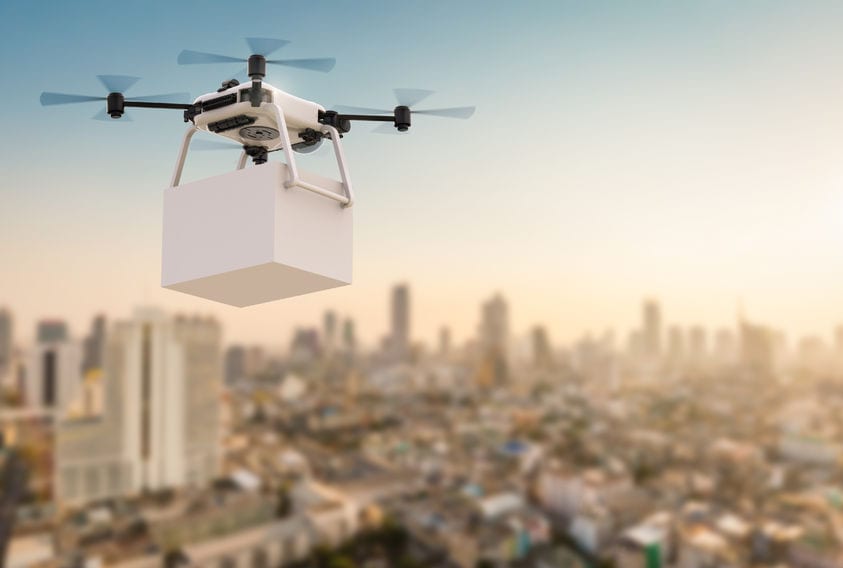In the near future, we will likely receive almost all of our deliverable orders by air mobility, as companies are looking at the potential of leveraging drones to transport items of different shapes and sizes. The latest technological developments allow companies to seek full automation of drone delivery services, as operational expenses would be highly reduced compared to the traditional delivery business model. Furthermore, fully automation could result in a high-rate delivery potential, with specific orders being fulfilled in under 15 minutes (Amazon Staff, 2022).
Drones used to be most often associated with the military (Lutkevich, 2022). However, the emergence of technologies has led to drones being equipped with new features and use cases for civilian roles – both for leisure and work purposes. For instance, AI enables camera drones to follow certain objects for videography and LiDAR drones are used to map archaeological landscapes.
While in the past three years, 660,000 drone deliveries were performed, in 2022, approximately 2000 drone deliveries were performed daily (McKinsey, 2022). The goods transported range from blood transfusions to food.
Will drones become commonplace?
McKinsey (2022) has identified three main factors affecting the development of the drone delivery sectors: regulation, public acceptance, and costs. First, the government-imposed regulations (e.g., airspace) will widely affect the adoption rate of this technology as unaccommodating circumstances might push back the deployment on a large scale. Second, drone deliveries must acquire consumers’ trust by demonstrating the accuracy and reliability of the technology in practice. Third, the costs of drone deliveries are essential for its adoption. As drone technologies directly compete with autonomous cars and ground robots, it is critical that the technology quickly matures to benefit from economies of scope and scale (e.g., decreasing the costs).
Tech giants such as Google and Amazon have already invested in drone technologies through their Wing and Prime Air subsidiaries. In the past, next-day deliveries have changed how we perceive delivery services – increasing the customers’ requirements. While the impact of drone mobility remains to be seen, it is evident that it will drastically change the current status quo.
References:
Amazon Staff (2022). Amazon Prime Air prepares for drone deliveries. About Amazon. Available at: https://www.aboutamazon.com/news/transportation/amazon-prime-air-prepares-for-drone-deliveries.
Lutkevich, B. (2021). What is a Drone? – Definition from WhatIs.com. IoT Agenda. Available at: https://www.techtarget.com/iotagenda/definition/drone.
McKinsey (2022). Drone delivery: More lift than you think. McKinsey & Company. Available at: https://www.mckinsey.com/industries/aerospace-and-defense/our-insights/future-air-mobility-blog/drone-delivery-more-lift-than-you-think.


Interesting blog! I can hardly imagine getting a parcel delivered by drone yet, this will probably be a few years away. I think it is also very important to look at how sustainable drones are, my expectation is that they are more sustainable than delivery by cars, but I am not sure. Also, it will be very difficult to regulate air traffic, how do you make sure two drones don’t collide? However, I am very curious to see if this is the future of delivery!
Hi Catalina,
Thanks for the insightful blog! An interesting topic and one of the “hot” trend/ innovative initiative that Amazon have promoting in the recent years together with their prime now services. It’s exciting to think about the future delivery serviced done by drone and we can receive our package right in our backyard. Yet, I share the same doubt and question with you in term of the possibility to make this business model a commonplace. Next to the three factors that you already mention in the blog (regulation, public acceptance, and costs), there are also more aspects and challenges that need to be look at such as:
– The efficiency of the drone delivery. The package delivered by drone normally need to meet a certain requirement on the dimension and weight so that the drone can operate and carry the package. Thus, it would be a challenge to delivery big package with large size or heavy item
– Routing optimization: Same as the truck delivery, once the business model begin to scale up, the routing optimization for the drone need to be take into consideration to avoid air traffic congestion
– Competitors: Once the proof of concept is success for this business model, more player in the industry would be interested in this model. Thus, a general regulation need to be made
– Customer services: How the customer services would be handle when the customer miss packages? or live in the apartment building?
Overall, the concept is very promising and worth to further investigate. Thanks for bring out this topic!